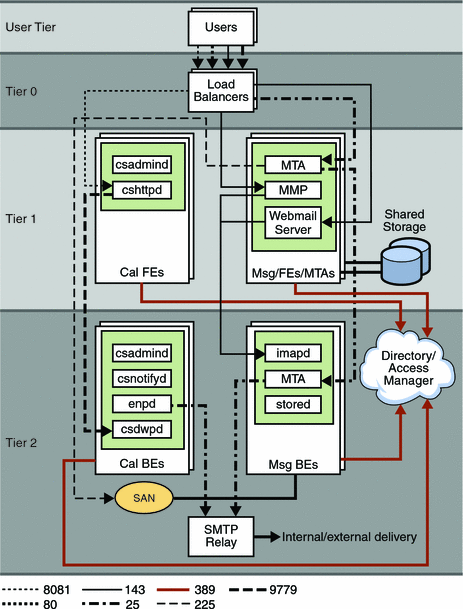Communications Suite Two-tiered Logical Deployment Example for Multiple Hosts
Figure 28–2 shows a two-tiered logical deployment example for Messaging Server and Calendar Server. Tier 0 consists of load balancers. Tier 1 consists of Calendar Server and Messaging Server front ends. The Calendar Server and Messaging Server back-end stores form Tier 2.
Directory Server and Access Manager are a complex deployment on their own. This figure represents those components by a “cloud.”
Figure 28–2 Communications Suite Two-tiered Deployment Example

In the preceding example, load balancers form Tier 0, and direct user access to the front-end services.
The front-end services consist of four machines. Two machines are installed with Calendar Server front-end components. These Calendar Server front-end machines consist of one or two CPU servers and their own internal disk storage. Two other machines are configured as Messaging Server proxies and MTAs, and share an external disk array. These Messaging Server machines consist of four CPU servers.
The back end also consists of four machines. Two machines serve as mail stores and run the Messaging Server processes. Two other machines serve as the calendar stores and run Calendar Server process. The store machines are attached to a Storage Area Network (SAN). These back-end machines can be deployed in a variety of ways, based upon your CPU needs. Once you determine the total number of CPUs, you can opt for a vertical or horizontal configuration. For example, if your architecture called for a total of twelve CPUs, you could use three four-way servers, two six-way servers, or even one 12-way server.
Another machine serves as an SMTP relay for both Calendar Server notifications and Messaging Server emails.
The following table explains the protocols and port numbers used by this deployment.
Table 28–2 Protocols And Ports Used by Two-tiered Deployment Example
- © 2010, Oracle Corporation and/or its affiliates
